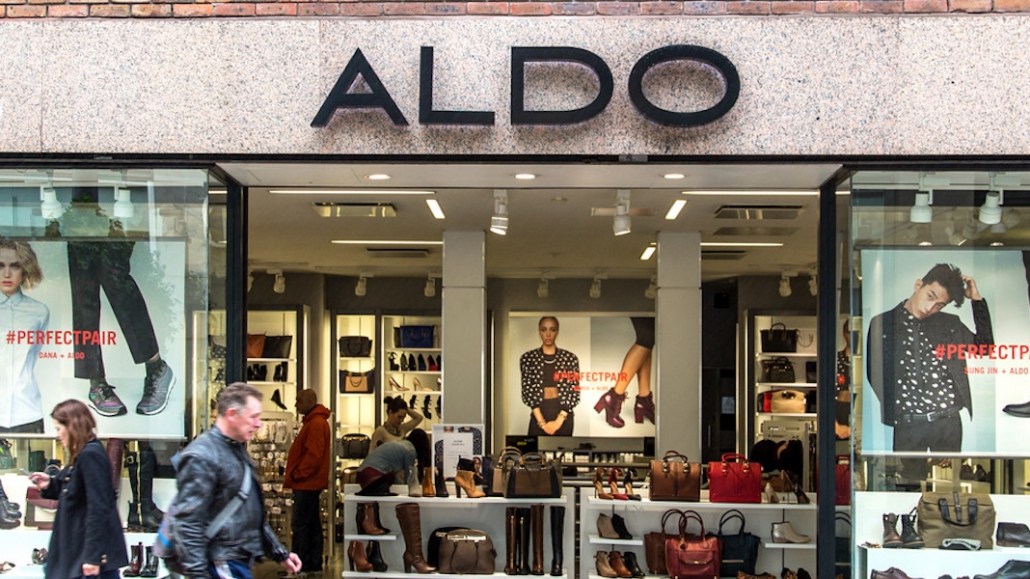
By scaling back promotions, integrating digital capabilities and focusing on global expansions, Aldo has been able to stay afloat in a market particularly hostile to mid-priced retailers with vast fleets of brick-and-mortar stores and a hefty mall presence.
The footwear and accessories retailer, which has 2,000 stores globally, expanded this week by redesigning its website for both mobile and desktop, and launching e-commerce in 10 additional countries. Previously, Aldo could only ship items online to customers in Canada, the U.S. and the U.K. The redesign, which puts more emphasis on product imagery and pulls in user-generated content from social media, is the retailer’s first major design and back-end overhaul in 10 years.
“We had been taking a new direction in smaller steps, so the sites were moving, but slowly,” said Grégoire Baret, general manager of omnichannel experience at Aldo. “Finally, we decided to take a stand to align our brand positioning with our customer needs. From a back-to-front end view, it’s all tied together.”
Aldo began working on its site relaunch back in late 2015, when it tapped the digital agency Work & Co to man the project. The relaunch overhauled Aldo’s back-end operations, while the new site design was laid out in order to “elevate the brand” in the eyes of consumers.
“More than just a website, this is a multi-year strategy overhaul for them,” said Rachel Bogan, a partner at Work & Co, who worked on the Aldo site relaunch. “A cohesive brand experience was new for Aldo. The old site was optimized only for conversion, so creating something more involved was important. They needed to bring it up to date.”

User-generated content on Aldo’s website
Aldo, a privately held company headquartered in Canada, has all the markings of a mall retailer, with a presence in an estimated 50 percent of America’s shopping centers. As mall neighbors like Bebe, Rue21 and Payless shutter stores, and mall titans like J.Crew, Gap and Abercrombie & Fitch struggle to stay relevant, Aldo seems to be surging. According to PrivCo, an online firm that projects private companies’ performances, the retailer brought in more than $2 billion in revenue in 2015, its most recent year reported by analysts. That’s up from a projected $1.85 billion in 2014. Both figures account for revenues from Aldo, as well as subsidiary footwear brands Call It Spring and Globo. Kashif Sheikh, marketing and investment analyst at PrivCo, said that Aldo’s 2016 revenue was predicted to either be steady or slightly down, as Aldo has stemmed its physical store openings.
According to Baret, Aldo’s online revenues climbed 15 percent in 2016 over 2015, while in-store revenue increased 5 percent in the same time frame. Mobile currently accounts for half of all online sales. Baret said that Aldo didn’t have any plans for major store closings.
“Other mall retailers that are struggling never integrated technology as part of the flow for associates, and now they’re playing catch up,” said Baret. “For many, it’s too complex, and they’re not up to par with customer expectations. We embraced technology from the beginning as a way to add better services.”
During the relaunch, back-end operations were rebuilt to act as a connective tissue between online, mobile and in-store. The company had recognized that the way customers shop today is driven by convenience, so it changed the way it fulfilled orders.
Online, orders can be placed to ship to a nearby store for free, or items can be reserved to try on at an Aldo location. Touch screens in stores let customers search for items by size and request try-ons — this eliminates the process of waiting for a salesperson to find a product in the back, just to realize they don’t have it in stock. On mobile, the newly relaunched site prioritizes product pages and simplified checkout, cutting through the noise of content that functions well on desktop but clutters the mobile page.
Aldo also built a new payment system, not yet rolled out in all of its stores, that allows customers to complete their purchases either with a salesperson’s mobile device or on their own phones in the company’s app.
A lot of these features — like buy online, pick up in store and free returns — have become table stakes for retailers, but they’re not as simple as flipping a switch. In addition to taking about a year and a half to launch, the redesign was an all-hands-on-deck experience for the brand, which involved removing silos between departments, according to Bogan. Crucially, the new site is built to expand and change alongside new technologies.
“About half of customers coming into stores had already researched their purchase online,” said Bogan. “Making a mobile-first web experience was really important, and the goal for Aldo was to get something flexible in place. What you see now in stores and online could be different a year from now, if it needs to be.”
Customers won’t easily identify the heavy lifting that went into redesigning Aldo’s back end, but they will notice that the brand has a new online and mobile look. Its product pages now include more imagery, product recommendations, styling tips and user-generated content. Critically, the retailer is also on a mission to curb its promotional cycles.
“Each year, we do fewer sales than we did the year before. Discounting is a trap, and we have to be careful,” said Baret. “We want [customers] dedicated to the products we offer, not the price points.”
More in Marketing

Pitch deck: How Amazon is recasting Twitch as a core part of its CTV pitch
Amazon is positioning Twitch as a defining asset in its CTV ambitions.

Netflix transforms former mall department stores into experiential venues
The location in Dallas opens this week, and one at the King of Prussia mall near Philadelphia opened last month.

Future of Marketing Briefing: AI has created a new talent paradox in programmatic agencies
The job isn’t execution anymore. AI handles that. The job is judgement.









